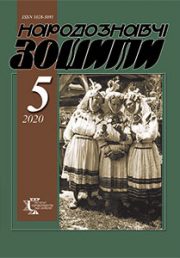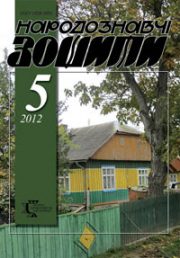The Ethnology Notebooks. 2022. № 1 (163), 202—217
UDK 930: 314.151.3-054.73(44=221.31)”19/20″
DOI https://doi.org/10.15407/nz2022.01.202
FORMATION OF THE AFGHAN COMMUNITY IN FRANCE AT THE TURN OF THE XX—XXI CENTURIES
SYPKO Bogdana
- ORCID ID: https://orcid.org/0000-0002-3136-9340
- Candidate of History, docent
- The Ivan Franko National University of Lviv
- Department of Modern and Contemporary History of Foreign Countries
- 1, Universytetska str., 79000, Lviv, Ukraine,
- Contacts: е-mail: bogdanasypko@gmail.com
Abstract. Introduction. The return of Taliban to power in Afghanistan in 2021 has provoked a new wave of refugees. Opponents of the new regime will seek political asylum primarily in Western countries, including France.
Problem Statement. The article clarifies the peculiarities of the formation of Republic’s Afghan community. This involves a number of tasks: to consider the characteristics of migration waves, to analyze France’s policy on Afghan refugees, to highlight the problems faced by newcomers and to trace the emergence of the first associations created by Afghans.
Purpose The sources of the study are reports of administrative organizations, NGO France Terre d’Asile, archives of the official journal and electronic yearbook of public non-profit organizations.
Methods. The general scientific methods of analysis and synthesis, as well as special scientific comparative-historical and chronological methods are used in the work. The author adheres to the principle of historicism.
Results. The first refugees from Afghanistan arrived at France in the late 1970s and 1980s, but it was a small number of members of Afghan elite. In the 1990s and early 2000s, the Republic served as a transit area for many Afghan refugees. The initial reluctance of Afghan refugees to see France as a destination is primarily due to the Republic’s strict adherence to the principle of laпcitй. After 2009 the French authorities had to respond to growing requests for asylum. Government proposed three alternatives: obtaining official refugee or subsidized status, voluntary repatriation, or deportation. After 2015 France became the direction of the «Secondary migration» of Afghans from Germany and Scandinavian countries.
Conclusion. The full-fledged integration of the Afghan community in France began in the second decade of the ХХІ century, when its rapid growth was observed. But the community is in the early stage of diaspora development, as evidenced by low proportion of women and small number of organizations created by Afghans.
Keywords: Afghan associations, Afghan community, asylum seekers, France, integration, refugees.
Received 11.01.2022
REFERENCES
- Centlivres, P. (2005). Afghan emigrations and the challenges of the return. Hommes et Migrations, 1253, 57—67. DOI: https://doi.org/10.3406/homig. 2005.4295 [in French].
- Centlivres, P. et Centlivres-Demont, M. (2000). Exile and the Afghan diaspora in Switzerland and Europe. CEMOTI, 30, 151—172. DOI: https://doi.org/10.4000/cemoti.645 [in French].
- Desoulieres, S. (2010). Traditional networks of solidarity at the heart of Afghan mobilities. Lien social et Politique, 64, 41—50. DOI: https://doi.org/10.7202/1001398ar [in French].
- Braakman, M. (2005). Roots and Routes. Questions of Home, Belonging and Return in an Afghan Diaspora. Leiden: Leiden University.
- Baraulina, T., Bommes, M., Cherkeh, T., & Daume, H. (2007). Egyptian, Afghan and Serbian Diaspora Communities in Germany: How do they contribute to their country of origin? Hamburg: Hamburg Institute of International Economics.
- Doxner, M., & Nicola, S.-L. (2017). Mapping of Report on the Afghan Diaspora in Germany. Bremen.
- Afghan Diaspora in Europe. Mapping Engagement in Denmark, Germany, Sweden and the United Kingdom (2019). Copenhagen: DANIDA.
- Mougne, C. (2010). Trees only move in the wind: A study of unaccompanied Afghan children in Europe. Geneva: UNHCR.
- Bathaпe, A. (2011). Long-distance family relationships. Afghan migration ethnographies. Autrepart, 57—58, 59—75. DOI: https://doi.org/10.3917/ autr.057.0059 [in French].
- Bathaпe, A. (2013). Istanbul — Athens. Circulatory practices of Afghans at the European borders. Hommes et Migrations, 1304, 27—33. DOI: https://doi.org/10.4000/hommesmigrations.2632 [in French].
- Toix, F. (2011). The Paris of the Afghans. Look at an invisible and precarious category of exiles from the 10th arrondissement. Paris: France Terre d’Asile [in French].
- Keyhani, B. (2020). Integration through economics. Dequalification of Afghan refugees. Travail et emploi, 161, 93—118. DOI: https://doi.org/10.4000/travailemploi.9888 [in French].
- Associations of law 1901. Directory of associations and associative news. Retrieved from: http://www.net1901.org/ (Last accessed: 19.10.2021) [in French].
- History of Esteqlal and Malalaп high schools. Retrieved from: http://lycee.kaboul.free.fr/index_f.htm (Last accessed: 19.10.2021) [in French].
- UN High Commissioner for Refugees (1997). UNHCR CDR Background Paper on Refugees and Asylum Seekers from Afghanistan. Retrieved from: https://www.refworld.org/docid/3ae6a6440.html (Last accessed: 19.10.2021).
- Fuchs, G. (2012). Leave Afghanistan: yes, but how? Revue internationale et stratйgique, 85, 40—49. DOI: https://doi.org/10.3917/ris.085.0040 [in French].
- Delouvin, P. (2004). Asylum in France today. Revue europйenne des migrations internationales, 2 (Vol. 20). DOI: https://doi.org/10.4000/remi.973 [in French].
- OFPRA. (2004). Activity Report 2003. Fontenay-sous-Bois [in French].
- OFPRA. (2007). Activity Report 2006. Fontenay-sous-Bois [in French].
- OFPRA. (2009). Activity Report 2008. Fontenay-sous-Bois [in French].
- France Terre d’Asile. (2009). Activity Report 2008. Paris [in French].
- France Terre d’Asile. (2006). Activity Report 2005. Paris [in French].
- France Terre d’Asile. (2007). Activity Report 2006. Paris: Stedi [in French].
- France Terre d’Asile. (2008). Activity Report 2007. Paris: Stedi [in French].
- Hebert, D. (2010, 23 march). Unaccompanied Afghan minors in Paris. Le Nouvel Observateur, 23 [in French].
- OFPRA. (2010). Activity Report 2009. Fontenay-sous-Bois [in French].
- The Afghan canteen (documentary 2012). Retrieved from: https://vimeo.com/86738744 (Last accessed: 19.10.2021) [in French].
- Eberhard, M., Le Mener, E., & Segol, E. (2018). Who are the migrants in the shelter? Report for the Ile-de-France Regional and Interdepartmental Department of Accommodation and Housing. Paris [in French].
- (2021). Asylum lottery. Afghan access to the protection in Europe. Report from the online public webinar on 25 May 2021. Danish Refugee Council.
- OFPRA. (2021). Activity Report 2020. Fontenay-sous-Bois [in French].
- (2019). OFPRA. Activity Report 2018. Fontenay-sous-Bois [in French].
- (2017). OFII. Activity Report 2016. Paris [in French].
- (2018). OFII. Activity Report 2017. Paris [in French].
- (2019). OFII. Activity Report 2018. Paris [in French].
- (2020). OFII. Activity Report 2019. Paris [in French].
- (2021). OFII. Activity Report 2020. Paris [in French].
- (2010). OFII. Activity Report 2009. Paris [in French].
- (2014). OFII. Activity Report 2013. Paris [in French].
- (2011). OFII. Activity Report 2010. Paris [in French].
- (2011). Immigration and integration policy figures. Year 2011. Ninth Report to Parliament. Paris: La documentation Franзaise [in French].
- (2011). The guidelines for immigration and integration policy. Year 2010. Eighth Report to Parliament. Paris: La documentation Franзaise [in French].
- (2017). Migration from Afghanistan to Europe 2014—2017. Research Report. Geneva: Reach.
- Interview with Mr. Christian Estrosi, Minister of Industry, to «LCI» on October 22, 2009, on the expulsion of 3 Afghans to Kabul, on the abolition of professional tax. Retrieved from: https://www.vie-publique.fr/discours/177081-interview-de-m-christian-estrosi-ministre-de-lindustrie-lci-le-2 (Last accessed: 19.10.2021) [in French].
- Interview with Mr. EricBesson, Minister of Immigration, Integration, National Identity and Solidarity Development, at Europe 1 on October 21, 2009, on the expulsion of three Afghans to their country and on the law asylum. Retrieved from: https://www.vie-publique.fr/discours/176926-interview-de-m-eric-besson-ministre-de-limmigration-de-lintegration (Last accessed: 19.10.2021) [in French].
- (2010). France Terre d’Asile. Activity Report 2009. Paris [in French].
- (2019). France Terre dґAsile’s action in the field 2018. Paris [in French].
- (2015). France Terre dґAsile’s action in the field 2014. Paris [in French].
- (2016). France Terre dґAsile’s action in the field 2015. Paris [in French].
- (2020). France Terre dґAsile’s action in the field 2019. Paris [in French].
- (2017). France Terre dґAsile’s action in the field 2016. Paris [in French].
- (2013). France Terre d’Asile Activity Report 2012. Paris [in French].
- Portrait of young Hamada. Retrieved from: https://www.france-terre-asile.org/interviews/item/23-portrait-du-jeune-hamada (Last accessed: 19.10.2021) [in French].
- Portrait of young Ashkan. Retrieved from: https://www.france-terre-asile.org/interviews/item/24-portrait-du-jeune-ashkan (Last accessed: 19.10.2021) [in French].
- Portrait of young Basharak. Retrieved from: https://www.france-terre-asile.org/interviews/item/26-portrait-du-jeune-basharak (Last accessed: 19.10.2021) [in French].
- (2014). France Terre d’Asile. Activity Report 2013. Paris [in French].
- (2013, 23 march). JORF [in French].
- (2014, 16 august). JORF [in French].
- (2021, 12 january). JORF [in French].
- (2015, 12 september). JORF [in French].
- (2018, 8 september). JORF [in French].
- (2013, 5 january). Emal, an Afghan harki. Aujourd’hui en France (P. 11) [in French].
- Sypko, B. (2013). From «Forgotten by History» to Subjects of Public Relations: Problem of Harki during the Presidency of Jacques Chirac. Spoleczenstwo i Polityka. Pismo edukacyjne, 3 (36), 229—239 [in Russian].





